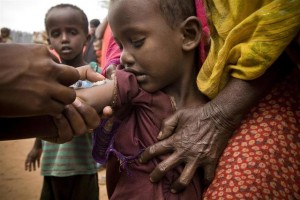「非洲之角」开展疫苗接种行动 保护营养不良儿童免患病死亡的生死綫
2011-07-26
奈洛比/香港,2011年7月26日——联合国儿童基金会(UNICEF)、肯尼亚衞生部及世界衞生组织本星期正式在北肯尼亚开展防疫注射行动,为达达阿比难民营周边社区的儿童接种疫苗。是次行动是预防灾区大规模爆发致命疾病重要的一步,预料可为202,665名5岁以下儿童,接种麻疹及小儿麻痺症疫苗,並为他们提供维他命A及驱虫药片,有效预防受灾儿童染上小儿麻痺症,及防止患有营养不良的儿童因感染麻疹而致命。

| 南索马里的防疫注射覆盖率只有26%,是全球比率最低的国家之一。UNICEF的救援队伍,上周四已在索马里首都摩加迪休开展有关行动,为当地8个地区及区内难民营的妇女及儿童进行疫苗接种,至今已接种疫苗的5岁以下儿童及妇女分別有有40,000名及46,000名。而在盖多,救援队伍亦正为当地6个地区预备麻疹疫苗、破伤风类毒素疫苗、维他命A及驱虫药片,预计将有55,000名5岁以下儿童及72,580名育龄妇女受惠。只要交通能够确保畅顺,UNICEF将与世界衞生组织合作,进一步将行动迅速扩展至加勒加度、大贝纳迪尔、拜洲、巴科勒、希兰、下谢贝利及朱巴,为各区合共250万名15岁以下受灾儿童全面接种麻疹疫苗。 |
「这是一次关乎儿童生死存亡的严重危机。」联合国儿童基金会东南非地区主任Elhadj As Sy先生指出:「很多时,儿童死亡並不只是因为饥饿,营养不良导致他们罹患各种疾病反而是最大的原因。因此,如果灾区的营养不良率再不下降的话,儿童的性命就岌岌可危了。」
据此,各组织将进一步扩大北肯尼亚的防疫注射行动,预计至本周五(7月29日)行动将可扩展至加里萨、Fafi、Lagdera及南瓦吉尔,並于8月为达达阿比难民营提供服务。UNICEF已准备好足够的麻疹与小儿麻痺症疫苗、维他命以及驱虫药片应付需求,並会支援社区的宣传及教育工作,帮助当地居民认识防疫注射的重要性。

麻疹是一种高传染性的疾病,在过于拥挤和衞生情况恶劣的环境下,极易迅速扩散,威胁营养不良儿童的生命。麻疹大大降低儿童的抵抗力,令他们很容易在营养不良或患上其他疾病的情况下,因感染致命疾病而死亡。尤其在灾难中,不少儿童会都会患上维他命A缺乏症,相比正常人,他们患上麻疹、疟疾或腹泻的机会率足高出25%。因此,给受灾儿童服用维他命A,能有效提高他们在恶劣环境下生存的机会。
UNICEF预计未来半年所需的救援资金,将达到港币23.4亿元(3亿美元),以为整个索马里南部灾区的儿童提供紧急救援及采取预防措施。我们将重点进行预防工作,为儿童提供医疗以及疫苗接种服务,以确保他们的生存与发展。









